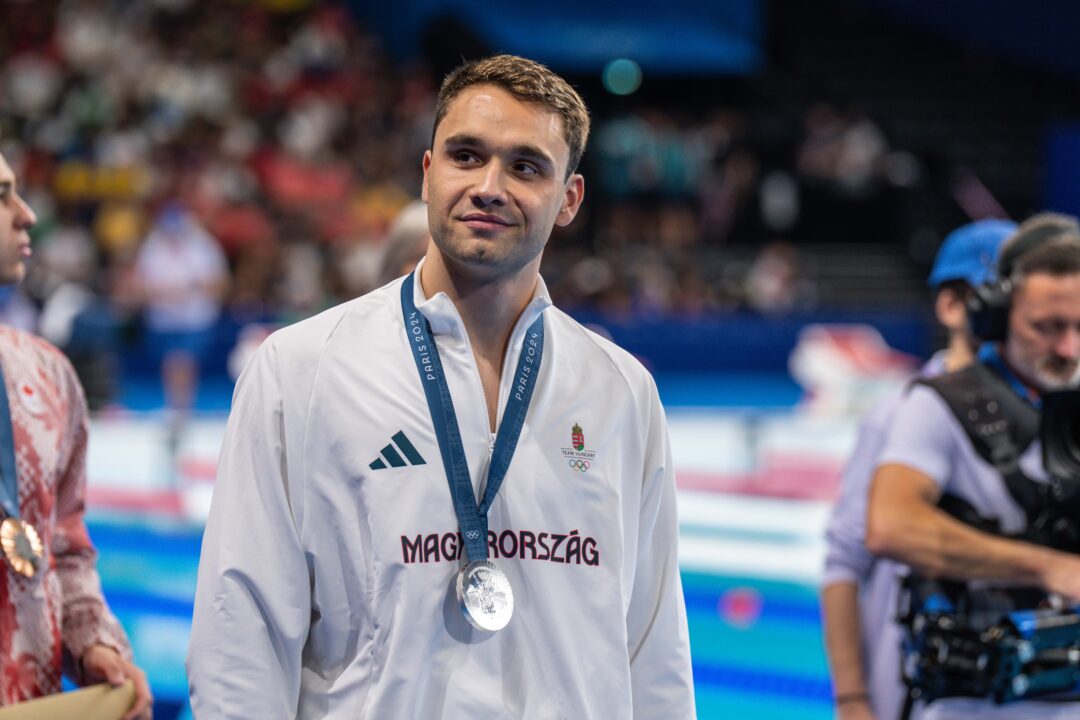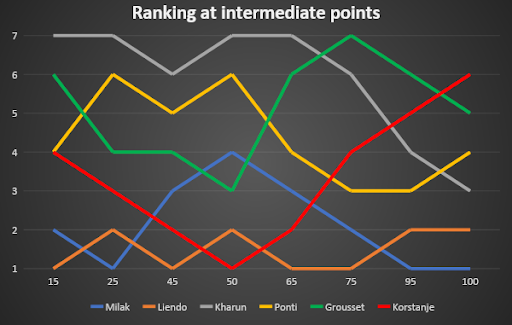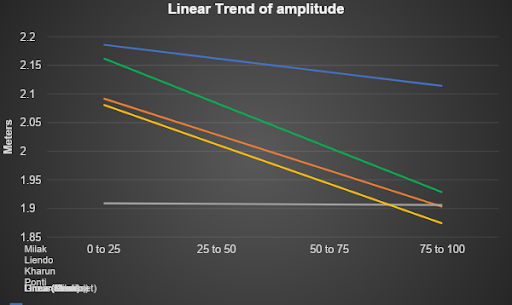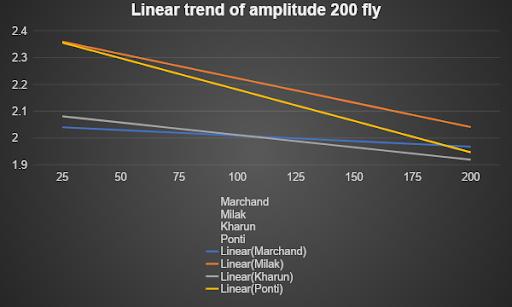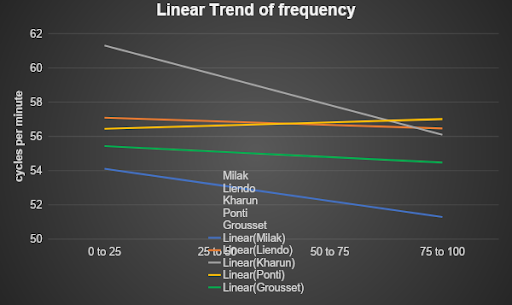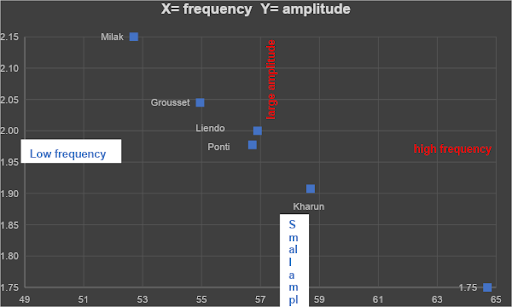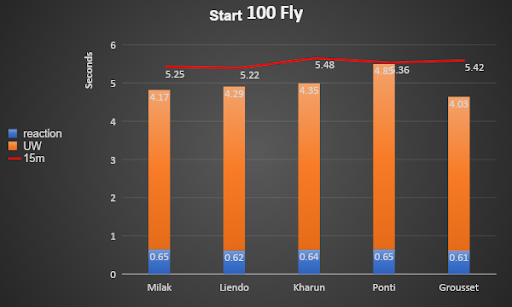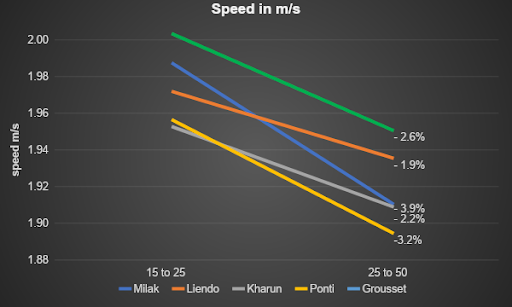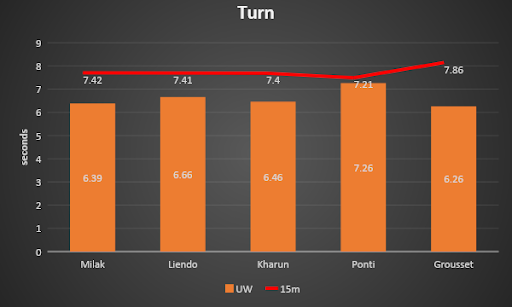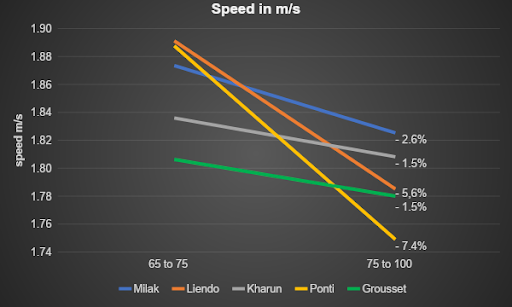Courtesy: Dominique Hérailh
This data is courtesy of the French Swimming Federation.
The French Swimming Federation has released detailed statistics on all the swimming finals at the Paris Olympics, and in this article, we’ll break down the final of the men’s 100 butterfly.
Given the results of the semi-finals, a close race was expected between six athletes separated by only three-tenths of a second.
Kristof Milak was the top qualifier, followed by Maxime Grousset +0.03, Josh Liendo +0.04, Nyls Korstanje +0.21, Noe Ponti +0.22 and Ilya Kharun +0.30.
We ended up seeing a duel between Milak and Liendo for the victory and a standout back half from Kharun who won his bronze medal in the last five meters.
→ Ilya Kharun‘s unique race (relative to the field)
Let’s check out the evolution of which position the swimmers were in throughout the race before diving into the data:
Kharun’s ranking alternated between seventh and sixth place up to 175 meters before gaining three places in the final 25 meters.
In the race for first, there were three successive leaders: Liendo, who was in the lead on four of the eight timed segments. Milak, who went from first to fourth before coming back to the lead between the 75 and 95-meter mark —where the lines cross on the graph above. Korstanje briefly held the lead at the turn.
Kharun’s second-to-last position before finishing third is not unusual for him, as he has a reputation for finishing races like a freight train.
However, looking deep into his stroke rate and distance per stroke (DPS) tells us how he was able to pull off such a quick finish.
In general, DPS tends to decrease with distance. Here is the graph of the Kharun’s DPS (amplitude).
Kharun’s trend line differs from the others. While the last amplitude is lower by 3-10% for the other four athletes, that of Kharun increases slightly (1.88m at the start vs 1.89m at the finish).
Let’s take a quick look at the same chart but for the 200 fly race where we had three of these swimmers. I’ll add a fourth, Leon Marchand.
The same characteristic is found but less pronounced. The decrease in DPS of Marchand is even smaller than that of Kharun but both are quite close. Is it due to the strategy of their coach, Bob Bowman, who favors a more consistent pace throughout the race? Perhaps this is due to both swimmers being more geared towards 200s than 100s.
Let’s go back to the 100 fly to see swimmers’ stroke rates and how they changed throughout the race.
Kharun’s low DPS led him to adopt a high stroke rate to maintain contact with the leaders.
Liendo and Ponti maintained their stroke rates at the expense of a significant decrease in DPS.
Grousset and Milak reduced their stroke rate to a lesser degree than Kharun.
Combining the stroke rate and DPS averages on a XY-type graph (below) we observe that only Kharun is in quadrant 4 (high stroke rate + small DPS).
Even if Milak is in the same quadrant as the other competitors, he stands out from his opponents thanks to the big DPS that he implements. By comparison, the DPS of Kharun is only 88.8% of Milak’s.
The blue line represents the equivalence of Milak’s performance at different DPS and stroke rates. To swim faster than Milak, it would have been necessary to make combinations «frequency x amplitude» on the right of the line (see below). The underwaters (start and turn) are not taken into account.
It is questionable, however, whether Kharun has found the best compromise between DPS and stroke rate. We will see in the details of the race that if Grousset had not missed his turn, third place could have been his.
Now let’s break down the race.
→ Let’s start by looking at how the gap between the top five evolved during the race
Josh Liendo was the most consistent up to 75 meters since he never lost more than three one-hundredths of a second on the respective leaders.
Grousset was only three one-hundredths back at the turn but had the worst turn of the eight finalists.
Kharun was already half a second behind at the 50 and continued to lose ground until the 75. The final 25 allowed him to pass Ponti to win the bronze medal.
→ Take a closer look at the race by analyzing the start, turn and “Over the Water” segments.
Start to 15 meters
Liendo and Milak were the fastest at the start. Matthew Temple, who is not on the graph, achieved an identical time (5.25 at 15 m).
By observing the histogram of Noe Ponti‘s times, we can detect an inconsistency that is perhaps linked to the positioning of the sensors underwater. Indeed, how can we explain that the exit from the underwater is timed at 5.50 seconds after the start while the passage to the 15 meters was timed at 5.36 seconds? His underwater length having been measured at 15.82 meters, even if it was the hands that were taken into account underwater, his head must have come out of the water at the cut-off.
Over The Water segments (first 50m)
Grousset dominated the first part of the OTW, which helped him catch up.
It can be noted that those who were the most consistent, either in DPS (Kharun) or stroke rate (Liendo), lost the least amount of speed.
50-Meter Standings
- Korstanje, 23.23
- Liendo, +0.01
- Grousset, +0.03
- Milak, +0.17
- Temple, +0.36
- Ponti, +0.47
- Kharun, +0.50
- Mizunuma, +0.80
Turn
Two highlights are worth noting:
- The excellent turn of Ponti whose flow was measured at 15.09m.
- The turn of Grousset which was the worst of the eight finalists. By losing time on Ponti (0.65) and the leaders (0.45), he missed the opportunity for a medal.
Over The Water (second 50 m)
Liendo and Ponti were the fastest through 75 meters but they could not maintain this pace. Both saw their efficiency decrease.
Milak was able to maintain enough speed to overtake Liendo 10 meters from the finish.
As for Kharun, his race strategy paid off but would have been more uncertain without Ponti’s drop in speed in the last 25 meters and without Grousset’s missed turn.
100-Meter Standings
- Milak, 49.90
- Liendo, +0.09
- Kharun, +0.55
- Ponti, +0.65
- Grousset, +0.85
- Korstanje, +0.93
- Temple, +1.20
- Mizunuma, +0.81
Conclusion
Undoubtedly, it was Milak who was able to find the best combination of frequency x amplitude. Few swimmers are able to maintain such a high amplitude with Milak’s frequency.
- Grousset was closest to Milak in terms of swimming speed
- Liendo lacked a little energy to finish the race. His 10 cm reduction in amplitude coming down the stretch was the most in the field.
- Ponti may have put too much gas into his final underwater off the turn and in the 10 meters that followed.
- Kharun was able to make the most of his race by favoring frequency over the length of the amplitude.
